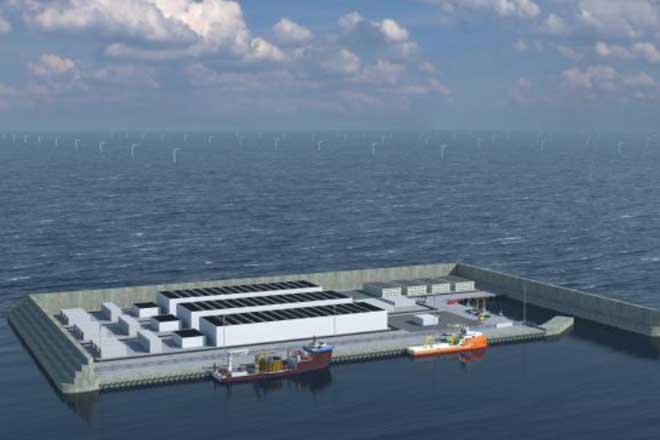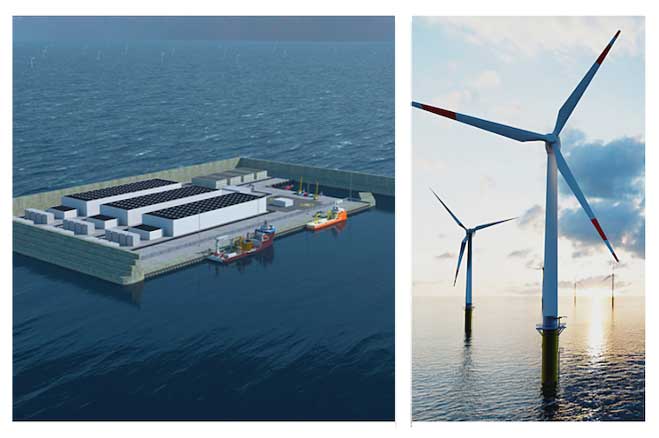Denmark to build its own ‘green’ island
Two energy Islands, one of them artificial, will one day power the entire country.

Two energy Islands, one of them artificial, will one day power the entire country.
Denmark aims to significantly boost the world’s offshore wind capacity with the two energy islands expected to begin operating in the Baltic and North Sea by 2030.
The islands will serve as hubs that collect electricity from the surrounding offshore wind farms and distribute the electricity between countries connected via the electricity grid.
One will be built on the existing island of Bornholm, while the other will be located in the North Sea and requires construction of an artificial structure. This artificial island will sit 60 kilometres off the Danish coastline west of Jutland and will be the size of around 18 soccer fields.
The islands will link to more than 600 giant 260 metre wind turbines strategically located offshore where the wind is stronger. They will capture enough energy to power the entire country, and as their capacity grows to an estimated 10 gigawatts by 2040, the power produced will exceed Denmark’s needs and could power as many as 10 million European homes.
Denmark built the first offshore wind farm in the world twenty years ago, and this latest project will be the largest infrastructure project in the history of Denmark. The island will hold batteries to store the energy and an electrolysis plant to produce green hydrogen.
A long-term ambition is to store green electricity on the island and convert it to liquid green fuel and send it via subsea cables to Denmark and neighbouring countries.
The Danish Energy Agency is tendering the joint ownership and the construction project to build the energy island in one major, consolidated international tendering procedure. The Danish state will own 50.1 per cent and the private owner 49.9 per cent of the energy island.
"We’ll secure a technical island design that will be built using both known technology, which means that it can be realised faster, and innovative and flexible solutions that can inspire globally"

More than 20 private entities and consortia have so far suggested solutions on how to best design the artificial energy island as well as the business model, according to the Danish Energy Agency, which plans to invite up to 10 commercial operators to participate in virtual dialogue meetings.
The business model and technical concept will focus on a flexible island concept that allows room to manoeuvre within the limits of regulatory and safety requirements. The tendering procedure for the island’s construction, however, was recently postponed to the middle of next year.
“Developing clever concepts takes time, but there’ll be rewards in the long run,” said Mogens Hagelskær, deputy director general responsible for the energy islands in Denmark.
“With a flexible reclaimed island, we’ll secure a technical island design that will be built using both known technology, which means that it can be realised faster, and innovative and flexible solutions that can inspire globally.”
Denmark is currently the largest oil producer in the EU, and it is the world’s biggest producer to establish a final phase-out date.
Last year Denmark reached a deal on the future of fossil extraction in the North Sea which led to the cancellation of the ongoing 8th licensing round and all future rounds to extract oil and gas.
The deal also established a final phase-out date of fossil extraction by 2050 and laid out plans for a just transition of impacted workers.
Around 200 wind turbines are expected to be operating in the first phase of the project, with up to 600 turbines expected to eventually surround the two energy islands.
Hagelskær said the Agency’s goal was to start supplying green energy from the energy island in 2033.
The tech
The artificial island in the North Sea will be around the size of 18 soccer fields. Initially, the North Sea hub will be capable of producing 3 gigawatts of electricity, but the plan is to scale up to 10 gigawatts. As well as supplying other European countries with electricity, the goal is to use the new offshore island to produce green hydrogen from seawater, which can also be exported. Large batteries on the island will store surplus electricity for use when demand is high. The energy hub will serve as an offshore power plant gathering and distributing green electricity from hundreds of surrounding wind turbines to consumers in countries surrounding the North Sea. The island is expected to have a total area of 120.000 square meters and in its first phase it will be able to provide 3 million European households with green energy.
Who funds it
The Danish government will own a majority 50.1 per cent stake with private companies to enter into a private/public partnership to build the project.
Is it ready to roll
Although some aspects of the project have been postponed to mid-2023, the aim to supply green energy from the energy island in 2033 remains unchanged.





